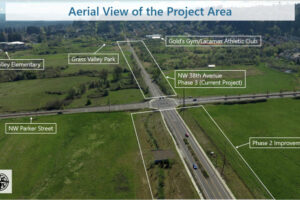He added that the consultants’ findings showed the intersection could be improved using either a traffic signal or a mini-roundabout, and that both options came with their own pros and cons.
“The option for the roundabout will (serve the intersection’s needs for longer than) our traditional 20-year option, but it costs more,” Camas Public Works Director Steve Wall told city officials in February, during a Council workshop. “On the flip side, you have a traffic signal that likely costs less but doesn’t serve us in the long-run and likely doesn’t even get us to the 20-year timeframe much less anywhere beyond that … If we continue forward, (the question is) ‘How much money do we want to spend and how far down the road do we want this to get us?’”
The public has had a chance to weigh in on the intersection improvements, Carothers said, adding that the City and its consultants have mailed postcards to 13,000 Camas households; had 200 responses to five social media posts; held three meetings with property owners and four interviews with other stakeholders; garnered 188 responses to an online survey; held an open house that attracted more than 60 attendees; and had 677 site visits with 137 people signing up for more information on the City’s Engage Camas website at engagecamas.com.
“We also talked to fire and emergency services,” Carothers added.
The consultants and Carothers plan to discuss the intersection improvements in more detail during the Council’s workshop on Monday, July 15, which begins at 4:30 p.m. at Camas City Hall and online via Zoom and the City’s livestream.
Carothers said he and consultants will discuss what they learned during their six months of public engagement, and will touch on questions they’ve had from city officials and community members, including: a cost comparison of the traffic signal versus the roundabout; private property impacts if the City opts for the roundabout option; the safety of bicycle and other users in a mini-roundabout; additional information about how staff determined the two preferred alternatives of a traffic signal or roundabout; where future growth is happening and why the City might not want to wait to improve the intersection until that growth occurs; the possibility and cost of conducting a noise study and possibly installing a sound barrier for property owners living near the intersection; and information about the City’s budget process and six-year street plan.





